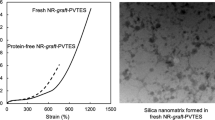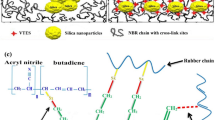Abstract
Natural rubber-grafted polyaniline with a nanomatrix structure was prepared and characterized. The graft copolymerization of aniline on natural rubber was performed in the latex stage. Factorial experimental design and univariate experiments were used to evaluate the effect of the factors on the conversion of aniline in the graft copolymerization. The structure of the products was characterized through 1H-NMR spectroscopy. The thermal properties, electrical conductivity, and morphology of the products were investigated. The results from the factorial experimental design showed that reaction temperature was the most important factor affecting the conversion, pH was the next most important, and the other factors were relatively unimportant. Polyaniline was confirmed to graft onto natural rubber and form a nanomatrix structure in the resulting material. The thermal properties and electrical conductivity of natural rubber-grafted polyaniline with a nanomatrix structure were improved compared to those of a polyaniline/natural rubber blend with an island-matrix structure.
This is a preview of subscription content, access via your institution
Access options
Subscribe to this journal
Receive 12 print issues and online access
$259.00 per year
only $21.58 per issue
Buy this article
- Purchase on Springer Link
- Instant access to full article PDF
Prices may be subject to local taxes which are calculated during checkout







Similar content being viewed by others
References
Moliton A, Hiorns RC. Review of electronic and optical properties of semiconducting π-conjugated polymers: applications in optoelectronics. Polym Int. 2004;53:1397–412.
Heeger AJ. Semiconducting and metallic polymers: the fourth generation of polymeric materials. Synth Met. 2002;125:23–42.
Sharma SK, Sehgal N, Kumar A. Biomolecules for development of biosensors and their applications. Curr Appl Phys. 2003;3:307–16.
Yuping D, Shunhua L, Hongtao G. Investigation of electrical conductivity and electromagnetic shielding effectiveness of polyaniline composite. Sci Technol Adv Mater. 2005;6:513–8.
Li W, Wan M. Porous polyaniline films with high conductivity. Synth Met. 1998;92:121–6.
Robert AD. Natural rubber science and technology. New York: Oxford University Press; 1988.
Gent AN, Kim HJ. Tear strength of stretched rubber. Rubber Chem Technol. 1978;51:35–44.
Yong KC. Epoxidised natural rubber–polyaniline dodecylbenzenesulfonate (ENR-PAni.DBSA) blends with adjustable electrostrictive properties. Polym Polym Compos. 2018;26:346–57.
Da Silva MJ, Sanches AO, Malmonge LF, Malmonge JA. Electrical, mechanical, and thermal analysis of natural rubber/polyaniline-Dbsa composite. Mat Res. 2014;17:59–63.
Khan I, Poh BT. Effect of molecular weight and testing rate on adhesion property of pressure-sensitive adhesives prepared from epoxidized natural rubber. Mater Des. 2011;32:2513–9.
Balberg I. Excluded-volume explanation of Archie’s law. Phys Rev B. 1986;33:3618–20.
Lehrle RS, Willis SL. Modification of natural rubber: a study to assess the effect of vinyl acetate on the efficiency of grafting methyl methacrylate on rubber in latex form, in the presence of azo-bis-isobutyronitrile. Polymer. 1997;38:5937–46.
Suksawad P, Yamamoto Y, Kawahara S. Preparation of thermoplastic elastomer from natural rubber grafted with polystyrene. Eur Polym J. 2011;47:330–7.
Yusof NH, Kosugi K, Song TK, Kawahara S. Preparation and characterization of poly(stearyl methacrylate) grafted natural rubber in latex stage. Polymer. 2016;88:43–51.
Nguyen TH, Do QV, Tran AD, Kawahara S. Preparation of hydrogenated natural rubber with nanomatrix structure. Polym Adv Tech. 2020;31:86–93.
Pukkate N, Yamamoto Y, Kawahara S. Mechanism of graft copolymerization of styrene onto deproteinized natural rubber. Colloid Polym Sci. 2008;286:411–6.
Kawahara S, Chaikumpollert O, Akabori K, Yamamoto Y. Morphology and properties of natural rubber with nanomatrix of non-rubber components. Polym Adv Tech. 2011;22:2665–7.
Kawahara S, Kawazura T, Sawada T, Isono Y. Preparation and characterization of natural rubber dispersed in nano-matrix. Polymer. 2003;44:4527–31.
Kosugi K, Sutthangkul R, Chaikumpollert O, Yamamoto Y, Sakdapipanich J, Isono Y, et al. Preparation and characterization of natural rubber with soft nanomatrix structure. Colloid Polym Sci. 2012;290:1457–62.
Gannoruwa A, Sumita M, Kawahara S. Highly enhanced mechanical properties in natural rubber prepared with a nanodiamond nanomatrix structure. Polymer. 2017;126:40–47.
Fukuhara L, Kako N, Thuong NT, Loikulant S, Suchiva K, Kosugi K, et al. Nanomatrix structure formed by graft-copolymerization of styrene onto fresh natural rubber. Rubber Chem Technol. 2015;88:117–24.
Kawahara S, Klinklai W, Kuroda H, Isono Y. Removal of proteins from natural rubber with urea, Polym. Adv Tech. 2004;15:181–4.
Sansatsadeekul J, Sakdapipanich J, Rojruthai P. Characterization of associated proteins and phospholipids in natural rubber latex. J Biosci Bioeng. 2011;111:628–34.
Cornish K. Similarities and differences in rubber biochemistry among plant species. Phytochemistry. 2001;57:1123–34.
Nawamawat K, Sakdapipanich JT, Ho CC, Ma Y, Song J, Vancso JG. Surface nanostructure of Hevea brasiliensis natural rubber latex particles. Colloids Surf A. 2011;390:157–66.
Tang SJ, Wang AT, Lin SY, Huang KY, Yang CC, Yeh JM, et al. Polymerization of aniline under various concentrations of APS and HCl. Polym J. 2011;43:667–75.
Marjanovic GC. Recent advances in polyaniline research: polymerization mechanisms, structural aspects, properties and applications. Synth Met. 2013;177:1–47.
Marjanovic B, Juranic I, Ciric-Marjanovic G. Reply to “Comment on ‘Revised mechanism of Boyland Sims oxidation’”. J Phys Chem A. 2011;115:7865–8.
Contreras EAZ, Leal MS, Escobar CAH, Hoshina Y, Lozano JFG, Kobayashi T. Synthesis of core–shell composites using an inverse surfmer. J Colloid Interface Sci. 2012;377:231–6.
Wang X, Sun T, Wang C, Wang C, Zhang W, Wei Y. 1H-NMR determination of the doping level of doped polyaniline. Macromol Chem Phys. 2010;211:1814–9.
Aubin M, Prud’homme RE. Analysis of the glass transition temperature of miscible polymer blends. Macromolecules. 1988;21:2945–9.
Saranya K, Rameez MD, Subramania A. Developments in conducting polymer based counter electrodes for dye-sensitized solar cells—an overview. Eur Polym J. 2015;66:207–27.
Acknowledgements
This work was supported by the Vietnam National Foundation for Science and Technology Development [Grant Code NAFOSTED 104.02-2017.20].
Author information
Authors and Affiliations
Corresponding author
Ethics declarations
Conflict of interest
The authors declare no conflict of interest.
Additional information
Publisher’s note Springer Nature remains neutral with regard to jurisdictional claims in published maps and institutional affiliations.
Rights and permissions
About this article
Cite this article
Nguyen, T.H., Tran, T.T., Kawahara, S. et al. Preparation of polyaniline nanomatrix formed in natural rubber. Polym J 52, 1357–1365 (2020). https://doi.org/10.1038/s41428-020-00403-9
Received:
Revised:
Accepted:
Published:
Issue Date:
DOI: https://doi.org/10.1038/s41428-020-00403-9
This article is cited by
-
Biocompatible membrane from the natural rubber-grafted-(2-hydroxyethyl methacrylate) and its metal removal application
Macromolecular Research (2024)
-
Discovery of island-nanomatrix structure in natural rubber
Polymer Journal (2023)
-
Properties of dispersions and films made of copolymers obtained from acrylic, methacrylic and vinyl monomers
Polymer Bulletin (2023)
-
Graphene matrix formation in a natural rubber dispersoid
Polymer Journal (2022)



